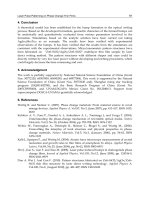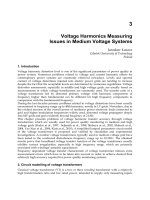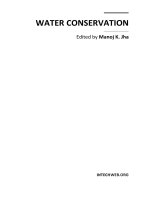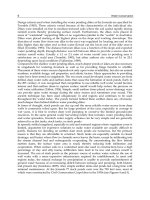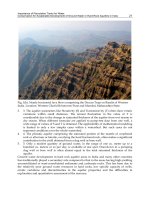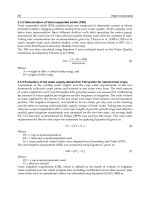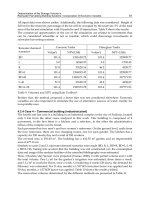Water Conservation Part 6 pptx
Bạn đang xem bản rút gọn của tài liệu. Xem và tải ngay bản đầy đủ của tài liệu tại đây (451.56 KB, 15 trang )
Water Conservation
66
Vittal K., Vijayalakshmi K., Rao U. (1983) Effect of deep tillage on dryland crop production
in red soils of India. Soil and tillage research 3:377-384.
5
Determination of the Storage Volume in
Rainwater Harvesting Building Systems:
Incorporation of Economic Variable
Marina Sangoi de Oliveira Ilha
1
and Marcus André Siqueira Campos
2
1
Department of Architecture and Construction, School of Civil Engineering,
Architecture and Urban Design, University of Campinas, Campinas, SP,
2
School of Civil Engineering, Federal University of Goiás, Goiânia, GO,
Brazil
1. Introduction
Rainwater harvesting has been used as a technique to promote water conservation in
buildings, as it substitutes the potable water in activities where the use of potable water is
not required.
In spite of the surge in interest over recent years, some questions still remain regarding to
these systems, mainly what involves the reservoir sizing. There are many methods for this
purpose that use different inputs such as: rainwater demand, catchment area, roof material,
rainy data (daily or monthly) and dry periods. Even in the Brazilian Standard (ABNT, 2007),
there is no consensus as to which method should be used. Table 1 shows the main methods
found in the literature and their respective inputs.
Mainly in developing countries, actions that promote water conservation must be
economically feasible so it can raise the interest in investments. Moreover, urban lots are
progressively smaller and more expensive. These variables can restrict the size
of the reservoirs used in a rainwater system and this should be considered in their
design.
This article proposes the use of an optimization technique to find the most adequate volume
of rainwater reservoirs i.e. the optimal economical result measured by the Net Present Value
(NPV): the Particle Swarm Optimization (PSO).
PSO is a population-based technique of stochastic nonlinear functions. Its use was
inspired by social behavior in flocking birds or school of fishes (Boeringer, Weiner, 2004).
It was used for this optimization process because of its flexibility and because it allows the
inclusion of other variables that might interfere with the NPV calculation in any given
future. This aspect expands the capacity of data processing without loss of efficiency of
the algorithm.
In this study, PSO was used to size rainwater reservoirs in four case studies and the results
obtained were compared with traditional methods that have been used for this purpose,
verifying the improvement of the decision making process.
Water Conservation
68
SIZING METHOD Source
Annual rainfall
Monthly rainfall
Daily rainfall
Catchemnt area
Annual Demand
Montly Demand
Daily Demand
Roof Material
Annual Average
Gould; Nissen- Pettersen
(1999)
x x
Brazilian Pratical Method ABNT (2007) x x
English Practical Method ABNT (2007) x x
German Practical Method ABNT (2007) x x
Australian Practical Method ABNT (2007) x x x
Rippl (Monthly data)
Thomas (2003); Campos
(2004); ABNT (2007);
Yruska (2010);
x x x
Rippl (Daily data)
Thomas (2003); Campos
(2004); ABNT (2007);
Yruska (2010);
x x x
Netuno
@
Guisi et al(2007); Rocha
(2009)
x
Numerical Simulations
Fewkes (1999); Liao et al
(2005); Liaw; Tsai (2004)
x x x x
Weibull
Group Raindrops (2002);
Simioni et al (2004)
x x
Table 1. Reservoir Sizing Methods and Inputs
2. Particle swarm optimization
The PSO algorithm is very similar to other evolutionary algorithms such as genetic
algorithms (GA): the system takes a starting point with a population of variables and then
research is done to find optimal solutions by the updating of generations. However, unlike
the GA, there are no evolution operators, such as crossovers or mutations. Potential
solutions, here called "particles", fly over the space of the problem, following the best
particles (Particle Swarm Optimization, 2009).
An individual (particle) in communities as flocks or schools learns not only with the
experiences that it had, but also with the experiences of the group to which it belongs. Thus,
this technique tends to provide the best personal experience (position visited) and the best
group experience.
The particles of PSO have a similar behavior. Through a simulation in a two-dimensional
space, the velocity vector defines the displacement of the particle and another vector defines
the position. The equations of these vectors are (Carrilho, 2007):
11
iii
kkk
pp
(1)
Determination of the Storage Volume in
Rainwater Harvesting Building Systems: Incorporation of Economic Variable
69
111 22
g
ii ii i
kk kk k
k
Crand b p Crand b p
(2)
Where:
k - an increase in pseudo-time unit;
ki
- position of each particle i (candidate solutions) in time k (iteration);
ki+1
- position of the particle i at time k +1;
b
ki
- best position reached by the particle i at time k - best individual position;
b
kg
- best position of the swarm at time k- is the best position reached by a particle used to
guide the other particles in the swarm;
v
ik
- speed of the particle i at time;
kv
ik+1
- set speed of the particle i at time k +1;
rand1 and rand2 - independent random numbers (with uniform probability) between 0 and
1.
C1 and C2 - control information flow between the current swarm: If C2 > C1 – particle
swarm will place confidence in the swarm, otherwise it puts confidence in itself. C1 and C2
are known as cognitive and social parameters respectively.
ω - inhere factor (or damping factor), which controls the impact of previous velocity of the
particle on its current speed.
There are many different fields of application for PSO. Wang et al (2009) investigated the
feasibility of the PSO algorithm to estimate the quality parameters of a water body. From the
results obtained, it was observed that the proposed algorithm provides satisfactory results,
either in relation to the genetic algorithm also developed for this purpose, or in the control
data. The authors concluded that it is an important tool for calibrating water quality models.
Another use of the PSO algorithm is for planning water supply systems (Yang; Zhai, 2009;
Montalvo et at, 2010). Yang, Zhai (2009) compared the results obtained with the application
of a genetic algorithm and PSO, demonstrating the flexibility of PSO, enabling the
adaptability of the optimization of discrete and continuous variables.
3. Methods
The present study consists of theoretical research which involves the following steps: Survey
of the methods that is regularly used in Brazil to size rainwater reservoirs, application of
those methods in four case studies, simulation of sizing considering such methods, and the
analysis of results; proposition of a tool to determine the volume based reservation.
The development of the PSO Tool involved:
a. Cost Estimation of each reservoir: The costs of the fiberglass tanks were obtained in
building material stores; and a local construction company gave the estimated costs for the
concrete tanks. From this, functions were created for the estimation of the costs of the tanks:
C = 0.1733V + 32.927 (Fiberglass tanks) (3)
C = 0.4672V + 12.791 (Concrete tanks) (4)
Where:
C – Cost of the tank (R$; US$1.00=R$1.66)
V – Volume of the tank (liters)
Water Conservation
70
b. Modeling of the water price policy – functions for the estimation of the tariff were used,
based on the values and classes of consumption by SANASA (Local water company).
For commercial buildings, these functions are:
V 10 m
3
P = 32,50
(5)
10 < V ≤ 20 m
3
P = 5,42V - 21,70 (6)
20 < V ≤ 30 m
3
P = 8,63V - 85,90 (7)
30 < V ≤ 40 m
3
P = 10,15V - 131,50 (8)
40 < V ≤ 50 m
3
P = 11,82V - 198,30 (9)
V>50 m
3
P = 14,25V - 319,80 (10)
Where:
V – water consumption (m
3
)
P - water tariff (R$; US$1.00 = R$1.66). The water tariff increase in the last 10 years was
considered to calculate the average, maximum and minimum values for the simulations.
c. Determination of the Net Present Value (NPV) function
d. Use of PSO technique for optimizing the NPV function for each volume estimated.
The PSO based approach suggested in the present work aims to establish the optimal
storage volume in a given rainwater harvesting building system, with regards to the
maximization of the system’s NPV. The system has two distinct modules: simulation and
optimization.
The simulation module calculates the system’s NPV over time, given a series of
precipitations and tariff rates based on previous data. The simulation module’s output is
final NPV to be utilized as objective function.
The optimization module is based on a PSO in its version with global topology (gbest or
global Best PSO). As previously described, the PSO is a search/optimization technique
based on swarm intelligence, where the position of each particle in the search space
represents a possible solution to the problem. In the suggested approach, the position of
the particle in a given instant represents a possible storage volume for the system with the
minimum volume (v
min
) determined by the user and maximum (v
max
) defined by the
building occupation rate and the storage’s maximum height. For the purposes of the
experiment described here, the occupation has been set as 0,05% and the maximum height
as 3m.
Initially, a 10 particle swarm was created and distributed uniformly in the search space on
the interval [v
min
, v
max
]. Then, the fitness of each particle was calculated and for each one its
pbest updated to its initial position. After that, gbest was defined as the position of the
particle with the best fitness in the swarm. In the following iterations, the particles update
their velocities according to the equation:
i
(t
1)
i
(t)
c
1
r
1
(t)[y
i
(t)x
i
(t)]
c
2
r
2
(t)[y(t)
x
i
(t)
]
(11)
Determination of the Storage Volume in
Rainwater Harvesting Building Systems: Incorporation of Economic Variable
71
where v
i
(t) is the velocity of the particle in the instant t; x
i
(t) is the position of the particle i in
the instant t, c
1
e c
2
are the acceleration constants that represent the social and cognitive
components of learning and r
1
(t) e r
2
(t) are random values sampled from a uniform
distribution U(0,1). These values have the objective of introducing a stochastic element in
the algorithm. In the experiments, the learning factors c
1
e c
2
were defined as 2. This value
was obtained empirically, establishing a satisfactory balance between search capability and
depth and width.
The best position found by a particle i so far (i.e., pbest) is represented by y
i
. As this is a
problem of NPV optimization, pbest is calculated as follows:
( ) 1
1
( 1) 1
iii
i
iii
y
tiffxt fyt
yt
xt if fxt fy t
Where
:
f
RR is the fitness function, represented as the NPV as function of the system’s
storage volume. If in a given instant t a particle x finds a position that produces a better NPV
than any previously found, its pbest is updated to the position of this particle in the instant t.
On the other hand, the development of the case studies involved the following activities:
a. Building selection: two aspects were considered in this selection - the building location
should be close to the University of Campinas, where the rainfall data were captured
and, and all design data should be readily available;
b. Rainwater demand estimation: rainwater was considered for supplying the following
non-potable uses: toilet flushing; landscape irrigation and floor washing. Six scenarios
of rainwater use were constructed: only for close-coupled toilet flushing (BD), only for
landscape irrigation (R), only for floor washing (L) and four combinations of these
scenarios: BD+R, BD+L, R+L and BD+R+L;
c. Rainfall volume estimation: the period for the analysis of rainfall data was from January
1971 through June 2009. Daily and monthly averages and maximum daily rainfall
intensity, periods of drought and their frequencies were also analyzed;
d. Selection of the methods for the determination of the reservation volume: the following
methods were chosen, based on the literature survey: Rippl (using daily and monthly
rainfall data); Weibull, Netuno
®
, and the practical methods recommended in the
Brazilian Standard: Azevedo Neto, English; Australian and German;
e. Sensitivity analysis based on different lifetimes and tariff value. There is no reference
for lifetime of these components in the literature investigated. Thus, a period of 20 years
was estimated for concrete tanks and 10 years for fiberglass tanks. For the water tariff,
adjustments made by the local water company were considered with the starting point
being the implementation of the Real (1994) by 2009;
f. Completion of the simulation, using the tool developed in this study.
An overview of the decision making process is shown from the results obtained, with a) the
“conventional” sizing method and sensitivity analysis and b) with the results of the
simulation. The sensitivity analysis provides a large number of options and outcomes to
assess the volume and demand that will offer the greatest financial return, measured by the
NPV of each situation.
The results were compared and analyzed in both the quantitative and qualitative aspects:
optimal volume, initial investment, and payback of the investment, efficiency, lot
occupation, and ease of use of the model including the input data. This analysis was made
Water Conservation
72
to verify the feasibility of using the PSO as a tool that can improve the decision making
process in the design of the rainwater system, taking crucial factors for the decision process
into account.
4. Results
4.1 Development of the PSO tool
Figure 1 shows the flowchart for the PSO tool. This flowchart was used to develop the RAIN
TOOLBOX
®
software. As mentioned earlier, the PSO technique was chosen for this
optimization process because of its flexibility, which allows the inclusion of other variables
that may have an impact on the future NPV calculation, expanding the capacity of data
processing, optimizing other variables besides the volume, such as the position of the
reservoir, treatment required, etc., without losing efficiency of the algorithm. The PSO was
shown to be a fast technique: the results were obtained in few seconds. The processing
speed depends on both the number of particles (volume) and the number of interactions.
This software allows choosing these variables.
Figure 2 shows the interface of the RAIN TOOLBOX
®
software. The first version is in
Portuguese, the English version is being developed. In square 1, the following input data is
required: Total area of the lot, catchment area, and rate of the lot will be used for the tank
and the runoff coefficient. Square 2 contains the input data concerning to costs of
implementation and maintenance (monthly, bimonthly, semi-annual and annual). The
material of the reservoir, the consumer class (to define the water tariff), the daily demand of
rainwater, and the maximum height of the reservoir are input in dialog box 3. Box 4 requires
the rainfall data and the historical water tariff adjustment to be input. Lastly, in Box 5, the
number of particles and interactions along with the minimum volume to be searched is
typed.
4.2 Case studies
The rainfall data of the studied region is characterized by a dry season, with long periods of
drought with an onset in April extending until August and a rainy season, from September
to March. In the period studied (1971-2009), the rainiest month was January, with 272mm
yearly average, followed by December (236mm/month) and February (193mm/month).
Yearly, in the aforementioned period, the rainiest year was 1983 (2619mm), and driest was
1978 (811mm).
4.2.1 Case 1 – Residential building
This case features a two-story building with two bedrooms, one with a suite (room with a
bathroom) and a restroom on the upper floor. Downstairs, it can be found a kitchen, a laundry
room, the living room and a bathroom. The house was designed to accommodate 5 people.
The lot is 450 m
2
, with the building covering 160 m
2
. The building is covered with ceramic
roof tiles and it has two roof surfaces. The yard is approximately 150 m
2
. The predicted use
of rainwater is for irrigation in the yard and toilet flushing. It was supposed that the yard is
irrigated once a week, using 1 liter/ m
2
, always from 06:00h to 08:00h.
It is estimated that each inhabitant flushes 6 times a day, 4 times being liquid and twice solid
waste. Thus, we have a total of 30 instances of use, 20 with partial volume and 10 with total
volume. Through previous observation, a daily distribution pattern was estimated.
Determination of the Storage Volume in
Rainwater Harvesting Building Systems: Incorporation of Economic Variable
73
Fig. 1. Flowchart of PSO Tool.
Water Conservation
74
Fig. 2. Interface of Rain Toolbox® - in Portuguese.
The volume used by the toilets is 136 liters per day. Considering the 150 liters utilized in the
yard’s weekly irrigation, we have a total consumption of 1102 liters a week. Over 4 weeks
(28 days), it was estimated that the demand for February is 4408 liters. For 31-day months a
1.107143 correction factor was applied and for 30-day months, a 1.071429 factor was applied,
the result is, respectively, 4880.29 liters and 4722.86 liters.
Table 2 presents the reservation volumes obtained with the aforementioned methods.
Method
Reserved
Volume (m
3
)
Efficiency (%) determined
according to Campos (2004)
Efficiency (%)
determined by
Netuno Software
Rippl Monthly 1,00 53 63
Rippl Daily 1,85 65 76
Practical Brazilian 33,55 100 100
Practical English 11,96 98 98
Practical German 3,45 76 85
Practical
Australian
1,00 53 63
Weibull’s Method 7,29 90 94
Netuno Software 3,50 76 85
Table 2. Reservation volumes obtained with standard methods e by Netuno Software – Case
Study 1 – residential building
Determination of the Storage Volume in
Rainwater Harvesting Building Systems: Incorporation of Economic Variable
75
Analyzing the obtained results, a considerable discrepancy can be seen in the results from
the Brazilian and English practical methods that yielded unexpectedly high values
considering the magnitude of the building. The other methods yielded reasonable results, all
feasibly applicable in a residence; nevertheless, with this information, it is still hard to
determine which value to use. Thus, it was decided that a sensibility analysis of the results
was to be made, with economic performance as criterion, which is also this work’s main
purpose. Each result presented in Table 3 was analyzed in terms of its economic efficiency of
investment, according to the flowchart in Picture 2.
It’s important to consider that the initial investment consists solely of the cost of storage, as
all other costs are fixed, independently of the volume of the storage.
The costs were estimated for concrete and glass fiber storages. To estimate the cost of the
storages, the previously explained model was utilized.
According to the estimated potable water demand (200 l/hab.day), the potable water
economy would be 4.88 m
3
, or U$10.84 monthly. However, as efficiency varies from volume
to volume, this value will be proportional to its volume. The operating and maintenance
cost was divided as follows: energy consumption – 30 working minutes per day:
US$13.43/month; chlorine for purification - 4 g/m
3
: US$0.03/month; cost of the analysis
according to the Brazilian Standard: chlorine and pH – US$0.43/month (using test strips);
turbidity – US$7.23/month; color – US$7.23/month; total coliforms: US$27.10 once a
semester; fecal coliforms: US$27.10 once a semester; system maintenance: cleaning of the
storage, gutters and pump – a domestic worker’s daily wage – US$37.59/year; cleaning of
the filter – half a domestic worker’s daily wage – US$37.59/year.
The monthly cost, based on once a semester and twice a semester, proportionally accounted
for US$49.86, which is higher than what would be saved in the best possible scenario for a
household (with 100% efficiency, US$10.87 would be saved monthly). Thus it can be
concluded that, economically, the investment would never return. However, there are other
factors, economics aside, that should be taken into account, such as the real value of water
and other environmental advantages.
So, even without economic advantages it is possible to choose a rainwater harvesting system
due to its environmental advantages. The chosen system, however, must be the least
economically disadvantageous. Table 3 presents the determined NPV values for each of the
aforementioned methods, as function of maximum, minimum and average adjustments of
the water tariff, which are respectively: 19.58%, 5.60% and 10.89%/year.
To apply the Rain Toolbox to case study 1, the height of the storage was limited to 3.00m
and it was established that it must occupy 5% of the terrain’s total area. The simulation,
using 10 particles and 10 iterations, yielded 3.00 m
3
as result. For the concrete storage, the
NPV was US$289.45 and for the fiberglass storage, it was US$5795.66. It was observed that
the volume determined by the software was the same as the minimum posited (in this case
3.00 m
3
was utilized to supply the daily demand).
What had already been shown was confirmed by traditional analysis; the costs
(construction, operation and maintenance) for the system in such residences are higher than
the returns: independently of the utilized volume there will be loss, and the lower the
volume, the lower the loss.
4.2.2 Case 2 – Institutional building
This case features an institutional building consisting of a group of classroom buildings of
the Faculty of Civil Engineering, Architecture and Urbanism of the State University of
Campinas.
Water Conservation
76
Method
Volume
(m
3
)
Minimum
Adjustment (5.60%)
Average Adjustment
(10.89%)
Maximum
Adjustment (19.58%)
20 years
(concrete)
10 years
(fiber)
20 years
(concrete)
10 years
(fiber)
20 years
(concrete)
10 years
(fiber)
Rippl
Monthly
1.00 -2970.00 -2470.28 -2787.27 -2395.44 -2197.27 -2226.84
Rippl Daily 1.85 -31075.60 -2473.69 -2888.83 -2382.23 -2182.55 -2176.20
Practical
Brazilian
33.55 -11576.60 -5485.16 -11240.10 -5344.46 -10153.50 -5027.49
Practical
English
11.96 -5608.31 -3278.75 -5278.52 -3140.87 -4213.69 -2830.23
Practical
German
3.45 -3450.34 -2559.99 -3194.59 -2453.06 -2368.80 -2212.16
Practical
Australian
1.00 -2970.00 -2470.28 -2787.27 -2395.44 -2197.27 -2226.84
Weibull 7.29 -4386.74 -2855.34 -4083.87 -2728.72 -3105.96 -2443.44
Netuno 3.50 -3464.21 -2565.13 -3208.45 -2458.20 -2382.67 -2217.30
Table 3. NPV values (in US$) for each method and adjustment – Case Study 1 – residential
building
It is comprised of three blocks, two already finalized and one still under construction. It
has a total area of 1500 m
2
, with four pavements. The total area for rainwater harvesting is
1222 m
2
, covered by metallic roof tiles. Each pavement has two restrooms, each with 5
sinks and 5 close-coupled toilets and the men’s restrooms have metallic gutter urinals. On
ground level, there are two restrooms; the men’s restroom has 5 close-coupled toilets, 5
sinks and 4 individual ceramic urinals. The women’s restroom has 6 sinks and 4 close-
coupled toilets.
The weekly average population at the time of this study was 2405 students, according to
UNICAMP’s administration. There was also a fixed population of 11. The irrigated area of
the yard is 30 m
2
.
A survey was made with regards to the frequency of use of the toilets, cleaning of the floor
and yard irrigation. To estimate the demand, as in the residential building, the existence of
double activation toilets was supposed. In this survey, 125 students were interviewed.
The average number of daily activations as surveyed was 0.90 per student. During 4 weeks
(20 days), the demand for February was estimated. For 31-day months a 1.107143 correction
factor was applied and for 30-day months, a 1.071429 factor was applied.
Using this data, different scenarios were made to analyze the use of pluvial water, according
to Table 4.
Determination of the Storage Volume in
Rainwater Harvesting Building Systems: Incorporation of Economic Variable
77
Scenario Projected Uses
Volume (m
3
)
February
31 day
Months
30 day
Months
BD Only flushing (double activation) 36.8 40.75 38.43
R Only irrigation of the yard 0.86 0.96 0.93
L Only floor washing 21.38 23.52 22.87
BD+R
Flushing (double activation) and
irrigation of the yard
37.66 41.70 39.36
BD+L
Flushing (double activation) and
floor washing
58.18 62.26 61.30
L+R
Irrigation of the yard and floor
washing
22.24 24.47 23.80
BD+R+L
Flushing (double activation) and
irrigation of the yard and floor
washing
59.04 65.22 62.23
Table 4. Rainwater Demand for each scenario.
Scenarios I II III IV V VI VII VIII
BD 6.58 13.95
256.28 91.34
28.54 6.00 61.95 8.50
R 0.00 0.03 0.68 0.00 1.36 0.70
L 0.00 2.44 16.65 0.00 35.07 7.00
BD+R 8.48 13.35 29.22 8.00 61.61 8.50
BD+L 54.40 58.95 45.2 31.00 95.30 15.00
R+L 0.00 2.71 17.32 0.00 36.53 10.00
BD+R+L 61.25 70.08 45.87 32.00 96.72 16.00
NOTES:– Rippl Monthly; II – Rippl Daily Data; III – Azevedo Neto Pratical Method; IV – English Pratical
Method; V – German Pratical Method; VI – Australian Pratical Method; VII – Weibull; VIII Netuno
Table 5. Reservation volumes obtained with the standard methods and Netuno software –
Case Study 2 – institutional building.
As in case study 1, the economical evaluation was made by calculating the NPV of various
methods, considering as cost only the construction of the storage.
In this case, there are various rainwater usage scenarios for the building. Hence, a series of
variables have to be considered, such as the usage of the pluvial water and the utilized
material (as in the previous case, 20 year lasting concrete and 10 year lasting fiber glass
storages were analyzed). The same adjustments as in the previous case were utilized here as
well: minimum, average and maximum in the period from 2001 to 2009, which were
respectively: 5.59%, 10.88% and 19.63%. To illustrate, Fig.3 presents the NPV of fiberglass
storage considering the minimum adjustment.
Water Conservation
78
Fig. 3. Fiberglass storage NPV – minimum adjustment rate. Case study 2: Institutional
Building.
It can be seen that the best NPV is yielded by the Brazilian practical method, utilizing
fiberglass storages with cost higher than US$150,60.
Furthermore, scenarios with lower demand (R; L and R+L) are less favorable than others,
nevertheless, if fiberglass is used, they show positive NPV for certain calculated volumes
(practical Brazilian, English and German). The scenarios constituted for case study 2,
independently of the method, were viable. This viability is largely due to high water taxes
for this topology.
Another important factor is the large harvesting area of this building. This allows for a
storage volume big enough to supply large demands, such as the ones estimated.
The result’s analysis poses other questions such as:
The Brazilian practical method usually yields large volumes. Despite this fact that when
utilizing fiberglass, the results are economically interesting when compared to other
methods.
Results obtained using Weibull or Netuno methods are usually economically viable
(NPV>0), independently of the demand scenario.
The Practical English method yields high NPV values for the calculated storages,
despite the material used, be it concrete or fiberglass.
The lowest NPV values for volumes calculated were obtained using the Rippl Method,
using either monthly or daily data.
The volume that yielded the highest NPV was calculated using the practical English
method, for flushing and yard irrigation (BD+R), with 91.34 m
3
, with value higher than
US$180,723, for the average adjustment rate.
If fiberglass storage were used, the highest NPV would be obtained with the volume
calculated using the practical English Method in a scenario of demand, considering the
average adjustment rate, approximately US$180,723.
As input to the simulation with Rain Toolbox, the total area is 1500 m
2
and the
harvesting area is 1500 m
2
. The storage height was limited to 3.00 m and its area to 5% of
the total area. The simulation with 10 particles with 10 iterations yielded the results seen
in Table 6.
Determination of the Storage Volume in
Rainwater Harvesting Building Systems: Incorporation of Economic Variable
79
Scenario
Concrete storage Glass fiber storage
Volume (m
3
) NPV (US$) Volume (m
3
) NPV (US$)
BD 161.24 223616.46 160.25 55835.69
L 1.00 6014.72 1.00 -1246.03
R 83.66 82617.96 7302 18840.31
BD+L 170.28 235312.23 16980 58903.62
BD+R 298.24 499238.69 295.38 128134.95
L+R 92.55 90275.09 75.62 20850.07
BD+L+R 303.39 511214.44 303.32 131277.15
Table 6. Reservation volumes obtained with Rain Toolbox. Case study 2 – Institutional building.
Analyzing the obtained results, it is possible to choose the highest NPV scenario, if the
budget is large enough. Moreover, it can be seen that, economically, concrete storages are
more advantageous than fiberglass storages.
Also, in scenario L, the financial return is very small or non-existent (if fiber glass is used).
The values for the storages calculated are relatively larger than the ones yielded by
traditional methods. However, the utilization of these volumes can maximize financial
return, making the implementation of rainwater harvesting systems more attractive.
4.2.3 Case 3 – Office building
An office building with 56 business rooms divided equally on two floors was selected for
this case study. Each room has one close-coupled toilet and one washbasin. This building
has not been built. The area in question is 1,431.40m
2
, the garden is 675.65 m
2
, the
impermeable area is 2,942.15 m
2
and the internal area is about 443.45 m
2
.
The estimated population is 757 people. The demand of rainwater was estimated based on
the literature. The estimated total number of toilet flushes per person per day is 3 (2 flushes
with approximately 3.5 L/f and 1 flush with about 7 L/f). An indicator of 1 L/m
2
was
considered for landscape irrigation and for floor washing. The frequency of these activities
is twice a week and once a week, respectively (Campos et al. 2003).
Based on these hypotheses, the rainwater demand for February was estimated as the
demand pattern. For months with 31 and 30 days, correction factors of 1.107143 and
1.071429, respectively, were used. Table 7 shows de results. Table 8 shows the volumes
obtained with use of those methods.
Scenario Projected Uses
Volume (m
3
)
February
31 day
Months
30 day
Months
BD Only flushing (double activation) 205,90 227,96 220,61
R Only irrigation of the yard 8,12 8,99 8,70
L Only floor washing 13,54 14,99 14,51
BD+R
Flushing (double activation) and irrigation
of the yard
214,02 236,95 229,31
BD+L
Flushing (double activation) and floor
washing
219,45 242,97 235,12
L+R Irrigation of the yard and floor washing 21,66 23,98 23,21
BD+R+L
Flushing (double activation) and irrigation
of the yard and floor washing
227,56 251,94 243,82
Table 7. Rainwater demand for different scenarios of use – case study 3 – office building
Water Conservation
80
Rainwater
demand
scenarios
Volume of the reservoir (m
3
)
I II III IV V VI VII VIII
BD 1038.6 1087.3
300.2 107.0
115.6 186.0 334.8 10.5
R 0.0 0.5 6.3 0.0 13.2 4.0
L 0.0 1.1 10.6 0.0 21.9 5.0
BD+R 1118.4 1167.8 115.6 195.0 348.0 10.5
BD+L 1171.6 1222.1 115.6 200.0 356.6 10.0
L+R 0.0 2.1 10.6 0.0 21.9 5.0
BD+R+L 1251.3 1305.9 115.6 209.0 369.8 10.5
Table 8. Reservation volumes obtained with the standard methods and Netuno software –
Case Study 3 – Office Building.
The NPV was determined for 6 situations: lifetime of 10 years (fiberglass tanks) and 20 years
(concrete Tanks) and 3 readjustment rates of water tariff, based on historical data: minimum,
average and maximum. Figure 4 shows the results for the average readjustment rate.
Concrete Tanks
Fiberglass Tanks
Note: US$ 1.00 = R$ 1.66 (02/18/2011)
Fig. 4. NPV for concrete/fiberglass tanks - average readjustment
